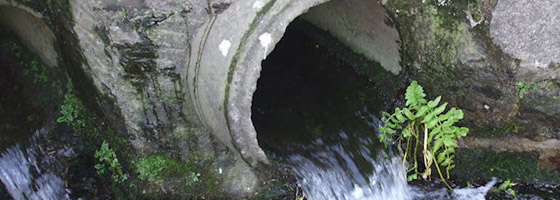Combined Sewer Overflow Monitoring Systems

An Overview of Combined Sewers
Streams are often diverted in urban areas into combined sewers in order to accommodate development in the flood plain. However, if sewers lack the capacity to handle both the sewage and storm water during heavy rain or snow melts, the sewer system will discharge excess wastewater directly into nearby streams, rivers, or other water bodies. These overflows, referred to as combined sewer overflows (CSOs), include not only storm water but also untreated human and industrial waste, toxic materials, and debris. The EPA notes that this is a major water pollution concern for the almost 800 U.S. cities that utilize CSOs, making combined sewer overflow monitoring a vital component to the safety and health of a number of U.S. communities.
CSO at Tanner Creek
In Portland, Oregon, a creek once ran through an area the city later expanded into. It was Tanner Creek, which had a watershed that extended about 1,600 acres. The creek stayed low if not dry during the summer, but it gushed with water during heavy winter rains. In order to accommodate further development, the creek was diverted into the sewer system, which originally drained directly into the Willamette River and the Columbia Slough until interceptor pipes and a sewage treatment plant were constructed in the 1940s and 1950s.
This system could not handle the storm water flows during heavy rains, though. Thus, the sewage water flowing to the treatment plant would overflow into the Willamette. These CSOs continued until the 1990s when the city of Portland started an initiative to avoid them; one of the major components of the plan involved keeping Tanner Creek water separate from the sewage and sending it directly to the river.
Application: Monitoring Combined Sewer Overflows on the White River
In many cases, however, channeling waste and runoff into separate sewers again is not possible, which can endanger water quality. The White River in Indiana, for example, has been besieged by a startling amount of pollution from spills, industrial discharge, and combined sewer overflows. In the interest of protecting the public health, the City of Indianapolis needed a system that allowed officials to gather water quality data from various points and analyze it for possible signs of contamination. The city contacted Fondriest Environmental to implement a real-time data collection network that provides officials with up-to-the-hour pollution and CSO data from multiple sites along the river.
Fondriest chose YSI 6600 multi-parameter sondes to monitor temperature, conductivity, dissolved oxygen, pH, ORP, and turbidity. Data from all sites are transmitted to a centralized computer via cellular modems on NexSens 3100-iSIC data loggers.
iChart software stores the data in a secure database and automatically posts real-time data to a local network drive where it is easily viewed by city personnel. The software automatically generates custom reports at set intervals, which simplifies data management and review. For immediate spill detection, alarms are set up to send emails or page someone when parameters are out of their acceptable ranges.
With this continuous, real-time data, the city is able to quickly respond to combined sewer overflows and other water quality impairments and identify contamination sources, as well as improve data quality, while saving time and money.
For more information about CSO solutions, contact a Fondriest Environmental application engineer at 888.426.2151 or email customercare@fondriest.com.
Image Credit:




0 comments